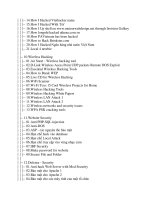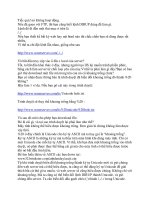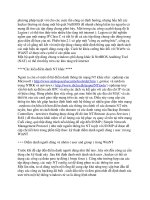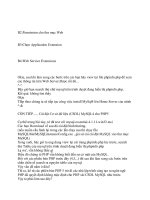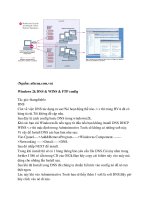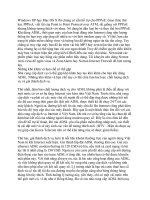HandBooks Professional Java-C-Scrip-SQL part 111 doc
Bạn đang xem bản rút gọn của tài liệu. Xem và tải ngay bản đầy đủ của tài liệu tại đây (26.99 KB, 6 trang )
Each method takes as a parameter a pointer to an NSZone, which isn't a class but
an opaque type. Normally you will not look any deeper into the zone parameter,
but pass it along to an inherited copy method like -allocWithZone: or a Cocoa
runtime function like NSZoneAlloc( ). See the Cocoa documentation for
information on how to use the runtime functions for allocating memory.
Since NSObject does not implement either protocol, you must adopt and
implement the protocols if you want your objects to support copying. Your class
will inherit from NSObject, whose methods -copy and -mutableCopy call
the respective protocol methods (with nil parameters) so you can use those
simpler methods to make copies of your class's instances.
If the distinction between mutable and immutable doesn't matter for your class (all
instances are mutable or all are immutable), just adopt NSCopying. If instances
may be one or the other kind, adopt both NSCopying and
NSMutableCopying, using the first for returning immutable copies and the
second for mutable ones.
If your class doesn't inherit any -copyWithZone: method, implement it using
+allocWithZone: and an initialization method. For example:
-(id )copyWithZone:(NSZone*)zone {
return [[self class] allocWithZone:zone ] init];
}
In this example, you evaluate [self class] to get the receiver of the allocation
message. Don't use the name of your class here. If you do, descendants won't be
able to inherit this method because the kind of object it creates will be hard-wired.
If your class inherits a -copyWithZone: method, you might not need to change
it, for example if your class doesn't add any fields. If you do override this method,
it should first call the same method on super before doing any further work. For
example:
-(id )copyWithZone:(NSZone*)zone {
MyClass * copy = [super copyWithZone:zone ];
// Further class-specific setup of copy.
return copy ;
}
If the inherited method returns a shallow copy, the copy will have two properties
you will have to correct:
· Its reference count will be identical to your own, and you will have to set
the count to 1.
· If it has any pointers to reference-counted objects, the counts of those
objects will not be properly incremented by 1 to reflect their additional
owner. You should set these fields to nil and then initialize them using the
appropriate setter method.
If you don't set a reference to nil first, the setter method may
call -release on the referent, leaving its reference count
permanently off by one.
If objects of your class are immutable, or there is only one instance that is shared,
just call -retain on the receiver and return it to the caller. For example:
-(id )copyWithZone:(NSZone*)zone {
return [self retain];
}
1.7.3 Deallocating an Object
The deallocation method of a class complements both the allocation and
initializers, undoing the work they did.
1.7.3.1 Calling deallocation methods
The Object class provides a -free method. Calling this method releases the
memory directly associated with the object. Memory directly associated with an
object includes the space taken up by that object's fields. If a field is a pointer to an
object or other structure, only the pointer will be freed. Subclasses should override
this method to adapt its behavior to free additional resources held by the receiver.
The NSObject class provides an analogous method called -dealloc. It has the
same behavior as -free, but you don't normally call -dealloc yourself on an
object. Instead you use the reference counting methods for memory management,
provided by Cocoa. When an object's reference count goes to zero, -dealloc is
automatically called. See Section 1.12 for information about using reference
counting.
1.7.3.2 Writing deallocation methods
If you're using the Object class, your code will call the -free methods directly.
In Cocoa, the runtime will send a -dealloc message to your object when its
memory is being freed via the -release message. In either case you use the
same approach to writing the deallocators.
Your class's deallocator should first release all resources that it has acquired, then
call its parent class's deallocator method:
-(id)free {
// Release held resources.
[super free]; // Tail call.
}
Notice that this chaining order is reverse that of initializing: a tail call instead of a
head call.
Descendants of NSObject will use -release instead of -
free.
Resources to be released include Objective-C objects held by reference (call -
free or -release on these) and external shared entities like network sockets.
The root class deallocator releases the memory of the object (i.e., its fields) itself.
1.8 Runtime Errors
Runtime errors include program errors like unhandled method calls or messages
sent to released objects, and hardware errors like division by zero. The Object
root class provides simple error-handling capability; the Cocoa framework
implements exception raising and handling.
1.8.1 Object Error Handling
When an error occurs, the runtime sets in motion the following sequence of events:
1. The runtime calls the -error: method on the object whose method
generated the error. You can override this method to customize error
handling for a particular class.
2. The -error: method prepares information about the receiver and passes
it to the runtime C function objc_verror( ).
3. The objc_verror( ) function calls the runtime error handler
function if there is one; otherwise it writes an error message to stderr.
You can provide a handler function to customize error handling for all
classes.
4. If the error handler exists (because you've provided one) and it returns
YES, execution continues; otherwise the program calls the C function
abort( ) and exits.
The GNU runtime provides a function to set your own error handler function:
objc_error_handler objc_set_error_handler(objc_error_handler f)
Calling this function sets a new error handler and returns the previous one. The
default error handler is a NULL pointer. The required signature of an error handler
is declared (in objc-api.h) as:
typedef BOOL (*objc_error_handler)
(id receiver,
int errCode,
const char* format,
va_list args);
Here are descriptions of the parameters your error handler will get:
receiver
The object in whose method the error occurred.
errCode
One of a set of integers declared in the header file objc-api.h along with
objc_error_handler.
format
A printf-style C string, for printing an error message.
args
A variable-length list of values for the format string. You can print the error
message using the format and argument list and the C function vprintf(
).
Use the first two parameters to decide how to handle the error, and the second two
to print a message.
1.8.2 Exceptions in Cocoa
The Cocoa framework contains an NSObject class that provides similar error-
handling to the GNU Object. However, Cocoa also provides a more elaborate
exception mechanism for handling errors.
An exception is a runtime event that diverts a program from its normal flow of
control. In the extreme case, the program will exit immediately. More generally,
control may jump across several stack frames, bypassing permanently the
remaining code in nested method calls. (Cocoa uses the C setjmp( ) and
longjmp( ) calls to implement this.) The Objective-C runtime or your code
may generate ("raise") exceptions to signal an event that must be handled in a
special way.
Cocoa's exception handling partitions your code into three types:
Try blocks
A block of code whose exceptions (if raised) will be sent to the immediately
following handler section. Always precedes a handler. (The term "try" is
borrowed from C++, even though Objective-C doesn't use it as a keyword.)
Handlers
A block of code executed if an exception is raised. A handler always follows
a try block.
Ordinary code
Any code that is not in a try block or handler.
These kinds of code play the following roles when an exception is raised:
· If execution is in a try block, control jumps to the subsequent handler.

